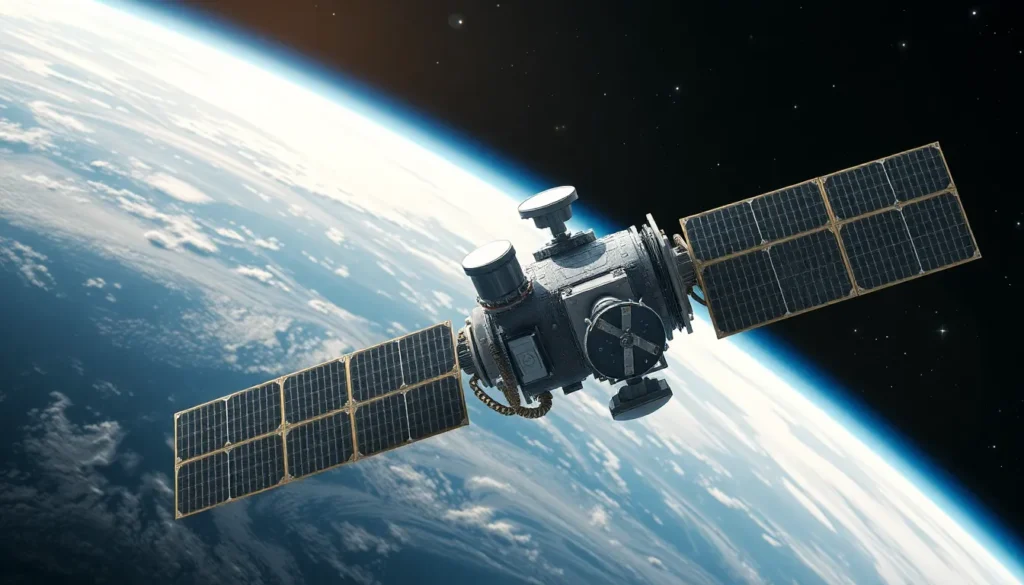Table of Contents
ToggleIn a world where staying connected is as essential as breathing, telecommunication satellites are the unsung heroes orbiting high above. These marvels of technology bridge the gap between continents, ensuring that no one misses out on the latest cat video or viral dance challenge. Who knew that a shiny metal dish spinning around Earth could hold the power to keep our social lives alive?
Overview of Telecommunication Satellites
Telecommunication satellites play a vital role in global communication networks. Operating in various orbits, these satellites transmit and receive signals for television, internet, and voice communication. They bridge geographical gaps, enabling connectivity in remote and underserved regions.
Geostationary satellites, positioned approximately 22,236 miles above the equator, remain fixed relative to a point on Earth. This stability allows for continuous communication coverage for specific areas. Low Earth Orbit (LEO) satellites orbit the planet at altitudes between 100 to 1,200 miles, providing lower latency communications, ideal for real-time applications like gaming and video conferencing.
Advanced technology enhances these satellites’ capabilities. High-throughput satellites (HTS) deliver more bandwidth, supporting a greater number of users and applications simultaneously. Ground-based stations ensure reliable control and communication, facilitating data relay between users and satellites.
The impact of telecommunication satellites extends beyond personal communication. Businesses rely on these satellites to maintain operations globally. Emergency services utilize satellite communications during disasters, ensuring coordination and response even when terrestrial networks fail.
Regulatory bodies oversee satellite operations, ensuring compliance with international standards. This regulation fosters collaboration between nations and satellite operators, promoting seamless connectivity around the world. With ongoing advancements, telecommunication satellites continuously evolve to meet increasing demands for data and connectivity.
Types of Telecommunication Satellites

Telecommunication satellites fall into several categories based on their operational orbits and functionalities. Geostationary and non-geostationary satellites represent two primary types, each with unique advantages and applications.
Geostationary Satellites
Geostationary satellites orbit approximately 22,236 miles above the equator. They maintain a fixed position relative to the Earth, allowing them to provide continuous coverage to specific regions. This feature makes them ideal for broadcasting television signals and delivering stable internet connectivity. Trade-offs include higher latency due to the distance, which can impact real-time communication applications. Operators frequently deploy these satellites for wide-area coverage, especially in rural and remote locations where ground infrastructure is lacking.
Non-Geostationary Satellites
Non-geostationary satellites encompass various orbits, including Low Earth Orbit (LEO) and Medium Earth Orbit (MEO). These satellites travel at lower altitudes, enabling reduced latency and improved communication speeds, which are crucial for applications like video conferencing and online gaming. Their deployment in constellations allows for global coverage, even in under-served areas. Additionally, advancements in technology have facilitated the launch of large fleets of LEO satellites, enhancing their capacity to meet increasing data demands. Non-geostationary satellites contribute significantly to expanding global internet access.
Key Technologies in Telecommunication Satellites
Telecommunication satellites utilize advanced technologies to facilitate reliable global communication. Two prominent systems underpin their efficiency: communication payloads and antenna systems.
Communication Payloads
Communication payloads empower satellites to transmit and receive signals. They often consist of transponders, which amplify digital signals for clarity during transmission. High-throughput satellites utilize advanced payloads to significantly increase bandwidth, allowing simultaneous connections for multiple users. These payloads also incorporate digital signal processing techniques, enabling enhanced error correction and noise reduction. With these advancements, telecommunication satellites can support various services, including internet, voice, and video communications.
Antenna Systems
Antenna systems play a vital role in signal transmission and reception in telecommunication satellites. Parabolic reflectors commonly focus signals to enhance strength and direction. Some satellites use phased array antennas to dynamically steer beams towards targeted areas. This adaptability allows coverage to be optimized based on user demand. Different frequency bands, such as Ku, Ka, and C bands, are employed to suit specific communication requirements. By utilizing versatile antenna systems, telecommunication satellites effectively bridge connectivity gaps across various regions.
Role of Telecommunication Satellites in Modern Communication
Telecommunication satellites play a vital role in enabling global communications. They serve as the backbone for internet access and broadcasting services.
Internet Access
Telecommunication satellites enhance internet access in both urban and remote regions. Satellites in Low Earth Orbit (LEO) and Medium Earth Orbit (MEO) reduce latency, supporting real-time applications like video conferencing. With advanced communication payloads, these satellites provide higher bandwidth for many simultaneous users. For instance, high-throughput satellites (HTS) allow greater connectivity options, enabling more individuals to access the internet without disruptions. This technology significantly expands coverage in underserved areas, bridging gaps where terrestrial networks fall short.
Broadcasting Services
In broadcasting, telecommunication satellites deliver reliable content to millions worldwide. Geostationary satellites continuously deliver television signals, ensuring viewers receive consistent programming. These satellites cover vast regions, making them essential for national and international broadcasting networks. Advanced antenna systems optimize signal transmission, adapting coverage to meet viewer demands. Furthermore, they support various formats, including HD and 4K broadcasting, enhancing viewer experiences. Broadcasting via satellites allows timely distribution of news and entertainment, providing seamless connectivity for diverse audiences.
Future of Telecommunication Satellites
Telecommunication satellites are on the brink of significant advancements. These technological innovations are set to redefine global connectivity and accessibility.
Emerging Technologies
Next-generation satellites integrate advanced features to improve performance. These innovations include high-throughput satellites (HTS), which provide increased data capacity. Additionally, the development of Low Earth Orbit (LEO) constellations enhances latency and speed, catering to real-time applications like video conferencing. More satellite manufacturers are exploring software-defined satellites, enabling on-the-fly changes to mission parameters. Innovations in antenna technology, like phased-array systems, support improved efficiency in signal transmission. These emerging technologies promise to bridge connectivity gaps, particularly in underserved regions.
Challenges and Opportunities
Operators face challenges regarding spectrum allocation and regulatory compliance. As the number of satellites increases, congestion in space may lead to potential collisions. Ensuring sustainable practices in satellite deployment is crucial for minimizing space debris. However, opportunities for growth abound with increasing demand for global internet access. Expanding into rural and remote areas offers significant market potential. Collaborative efforts among industry stakeholders can drive innovation while addressing regulatory challenges. By overcoming these hurdles, the telecommunication satellite sector can unlock new pathways for connectivity and service enhancement.
Telecommunication satellites are pivotal in shaping the future of global connectivity. Their ability to provide internet access and broadcasting services transcends geographical barriers, fostering communication across diverse populations. As technology advances, innovations like high-throughput satellites and next-generation systems promise to enhance performance and efficiency.
The ongoing efforts to address challenges such as spectrum allocation and space congestion highlight the industry’s commitment to sustainable practices. By prioritizing collaboration among stakeholders, the potential for expanding internet access to underserved areas becomes increasingly attainable. The evolution of telecommunication satellites will continue to play a vital role in connecting the world, ensuring that everyone can participate in the digital age.





